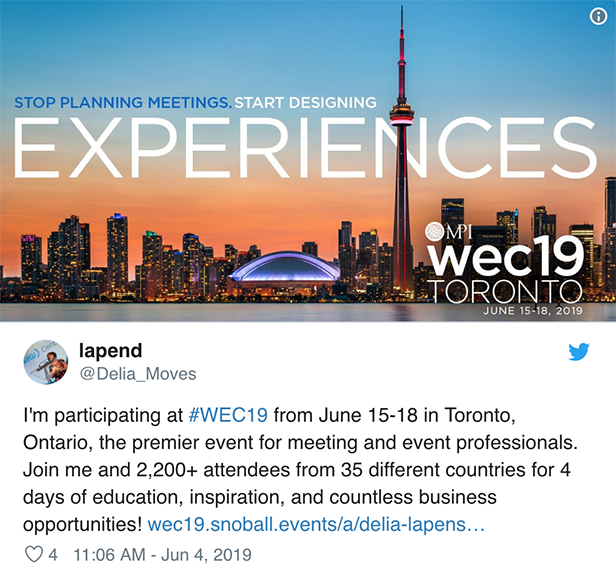Snöball’s Influencer Marketing Extends Event Amplification

Event marketers are used to seeing a lot of buzz onsite at their events. Between messaging pushed out by the host organization itself, social media sharing and media coverage, an event is a hive of marketing activity. But what’s often lacking, says Rachel Stephan, chief snöballer at snöball, is the authentic voice that comes from the people who are actually experiencing the event — the attendees, speakers, partners and exhibitors.
That’s the idea behind snöball, a digital tool that helps event organizers harness the power of influencer marketing and put it to use at their events: to provide a way for those event participants to easily share your message through the filter of their own personal experiences.
“With influencer marketing, you’re giving the megaphone to your influencers, because [the message] is more authentic coming from them,” Stephan says.
Ideally, the buzz should start long before your event takes place, helping to raise awareness and excitement to drive attendance, media awareness or any other goals around visibility, she adds.
In an initial snöballcampaign, everyone involved with the event is considered an influencer. Snöball provides your influencers with the assets and tools they need to advertise the event. For a speaker, these communications focus around the fact that they’re speaking, their topic, the date and time. For an exhibitor, it would be their booth number and what they’re demoing. The content could be anything that will help your influencer promote their participation and become an advocate or ambassador for your event.
Snöball recently launched additional services designed to expand content and extend event marketing amplification even farther. These new offerings, which can be considered a “phase two” of the campaign, allow event planners to take influencer engagement one step further.
The first new service is focused on retargeting. Snöball takes all the data gathered from the initial campaign and figures out who your most engaged — and engaging — advocates are. Then, the company works with that specific segment to further amplify your message by retargeting all the people who may have visited the assets or landing pages shared by that influencer. The idea behind the retargeting is that the more times those prospects see your event advertised, the more likely they are to click through to your landing page and hopefully decide to register.

This retargeting can also be expanded to include “lookalike” audiences, whose demographics mirror that of those who have engaged with your influencers.
The second offering is centered around co-creation of content with these highly engaged influencers. Based on the data, they are the people sharing the most event-related content and getting the most hits on their landing pages — so they are already extending your reach. Why not work with them to create a piece of content that can be used year-round?
Snöball will approach these influencers on your behalf, and working with you, will take charge of creating this new content. It could be a short interview video, or a 30-second video clip of them talking about what people will learn at their session, or why they are excited about the event. Post-event, it could be a video telling people what they missed, and driving them to recorded sessions, slides or other content on your site that may be of interest.
Stephan says that essentially people come to events for two things: networking and education. And they are looking for content that will help them make a decision on which events to attend.
“[These video clips are] a low-key authentic way to get that piece of content,” Stephan explains.
She adds, “Here is a video from the speaker themself about the topic. We give it to them to use on their landing pages, so they have another way to promote their participation. And from a meeting planner point of view, you now have a great content asset to use in your marketing campaign.”
Stephan also notes that these video clips come across as more authentic because they aren’t highly produced and polished.
These pieces of content can also be repurposed into additional content. Say there’s a recorded conversation with a speaker on a specific topic of interest for your event. That could be turned into a blog post, or quotes could be used in a compilation of testimonials. All this new content can be used to improve not only your event website but also your marketing campaigns throughout the year.
“You can include these pieces in your email marketing and it's great for inbound to bring traffic back to your site,” says Stephan. “It creates more variety and more content for your campaigns.”
Snöball has also just released a new guide to event influencer marketing, to help event marketers learn how to better engage with influencers.
To learn more about launching your own snöball, go here.
Download your complimentary copy of the Event Influencer Marketing Guide here.
Don’t miss any event-related news: Sign up for our weekly e-newsletter HERE and engage with us on Twitter, Facebook, LinkedIn and Instagram!


Add new comment